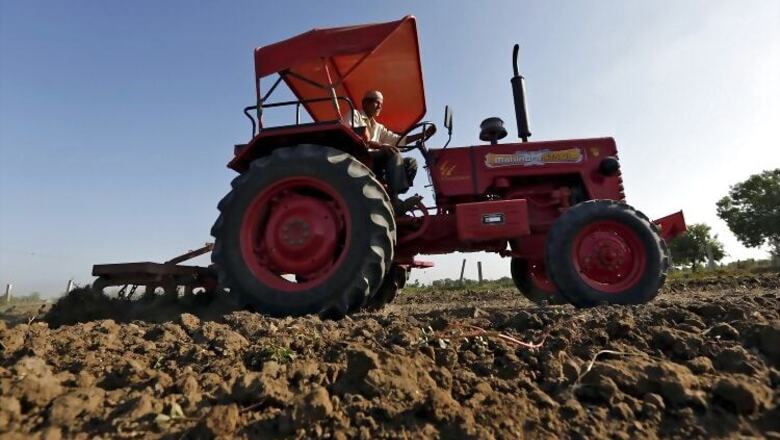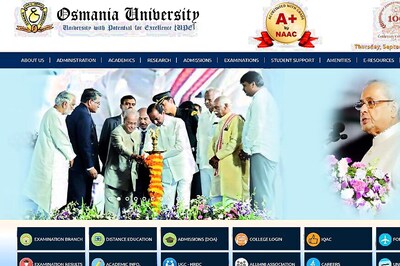
views
Smart agriculture is impossible without smart seeds. Seeds have technology embedded in them. The Pusa institute in Delhi made the first green revolution possible by providing farmers dwarf varieties of high yielding rice and wheat which transformed India from a food importing nation to an exporting one. Its latest contribution is a basmati variety called 1509 developed after seven years of research. It was released in 2013 and matures in 120 days, that is, 25 days less saving six irrigation and plenty of water.
India is rice country. It is grown in all states and covers forty-four million hectares. In 2013-14, India produced 106 million tonnes of rice. Rice needs a lot of water, a resource that must be used judiciously, especially in low rainfall areas like Punjab. With weather patterns getting disturbed and a growing population to feed, India needs climate resilient crops that mature in a shorter time.
Ashok Kumar Singh, Head of Genetics, IARI, said, “Obviously, we have to provide the technological options for example most of the varieties if we do not talk about non basmati varieties, the duration is longer about 145 days to 150 days. In basmati too, traditional basmati has 160 days duration. The most widely Pusa basmati 1121 has 145 days duration. So if we can reduce the duration to say about 120 -125 days, the future belongs to short duration varieties of rice, wheat or any other crop, which is increasing cropping intensity to enhance the profitability of farmers.
Maize is a cereal whose production is linked to rising GDP as people tend to consume more proteins in the form of meat, eggs and milk, when incomes rise. This in turn drives demand for maize as animal feed. India’s maize production has doubled to 24 million tonnes over the past one and a half decades. The country’s maize yield is about two and a half tonnes, though states like Andhra get more than six tonnes per hectare on average. Single cross hybrids have played a big role. Punjab wants to reclaim a part of rice acreage for maize, to arrest the depletion of groundwater, but the incentives for farmers to shift do not seem to be right.
Suresh Kumar, Additional Chief Secretary, Punjab, said, “Wheat and paddy has assured market. Maize and other crops do not. While we are giving lot of support on seeds, mechanization, inputs, hybrids and agronomy but farmer is not getting remunerative prices and until that happens farmers will not shift.”
There is extensive hybridization of maize even in Bihar which does not usually rank high on most indicators of progress. Small holders there do not mind buying seed from private companies as they are assured of high yield. The state grows maize in winter. While average yield is three tonnes, there are farmers who extract eight to ten tonnes per hectare.
Sudhanshu Kumar said, “I think the first reason is the seed. My father used to do a lot of maize and even we did maize. But this single hybrids and new varieties there has been a dramatic change in yield. When we compare it to earlier maize which we used to do it was not profitable. But with the dramatic increase in yield with the latest seed has made all the difference. Obviously seed cannot be the only reason but it is the single most important.
Bt cotton is another example of seed technology transforming crop economics. India’s only genetically modified crop, farmers have taken to it so readily that it now covers 95 percent of India’s cotton acreage. The Bt gene makes cotton resistant to a deadly and stubborn pest called bollworm, which persist despite several applications of costly chemical sprays. With Bt cotton’s assurance of pest protection, farmers have increased area the crop from nine to 12 million hectares. Annual output has tripled from 10 million bales in 2001-02 to 36 million. Pesticide use for controlling the bollworm has shrunk from 4,470 tonnes in 2002 to 222 tonnes in 2011. From being an importer, India has become an exporter of cotton.
Rustam Jamaluddin Turak, Farmer, Village Selsura, District Wardha, said, “I am benefitting from Bt. Yield is increasing. I get 8 to ten quintals. If there is good moisture and we give good fertiliser, the output can go up to 15 quintals an acre.”
Ironically Bt cotton faces opposition from some of its own supporters. They are not comfortable with the private sector’s hold over it. This, despite bt cotton seeds being under price control in some states. Opposition of this nature comes at a price. India is short of pulses and imported 2.7 million tonne last year for 8,800 crore rupees. If Bt technology had been applied to pigeonpea or arhar and chickpea or chana, damage by the pod borer could have been contained and India’s import bill would have shrunk.
C Lakshmipati Gowda said, “Former Dy D-G, Icrisat: But the major problem still remains is the pod borer, which is a major problem and that is where we do not have good available resistance in the local varieties so we have to depend on genetic modification. This is where Bt chick pea or Bt pigeon pea are going to be of help but scientists are constrained because we cannot go field level trials because there is a moratorium on this but if that can happen, that will be the biggest rev oltuion that can happen in both chick pea and pigeon pea if we can get both Bt chick pea and Bt pigeon pea which can reduce the damage by pod borers.”
Opposition to Bt technology might get muted now that a team of Delhi University researchers has provided their own version of it to the central institute of cotton research and Punjab agricultural university. These institutions will put the Bt gene in their open pollinating varieties whose seeds farmers can save and re-use unlike hybrids which private companies sell. The research was publicly funded, so the researchers want it to be used for the public good. They hope this will also blunt opposition to another of their invention – genetically modified mustard – which could slash India’s import of oilseeds.
Banana growers like Tenu Borole and Lakshma Onkar Chaudhari are proof that good seeds will not deliver high yields without sound agronomic practices. These farmers plant high-yielding saplings of Honduran Grand Nain bananas cloned in test tubes. They use drip irrigation to regulate moisture and humidity in the banana gardens as well as to supply precise amounts of nutrients. The combination of tissue culture, drip irrigation and fertigation has made Jalgaon district the highest producer of bananas in the country. If it were a state it would have ranked fifth in banana production.
Tenu Dongar Borole, 61, Village Nhavi, Taluka Raver, District Jalgaon, said, “I do not need to save water because there is enough but if i give more it is not good for the crop. In cold weather, we need to give one hour of water instead of six. In flood irrigation we cannot give water daily. We do it once every few days because we do not manually. But with drip we can do the whole field in one go and also calibrate it every day.”
In Gujarat’s Banaskantha district, farmers on contract to a supplier of finger chips to a multinational fast food chain have learnt scientific ways of growing potatoes. They use sprinkler instead of flood irrigation. Some of them like Parthi Chaudhary have managed to get very high yields by respecting the rhythm of nature and of the crop.
Parthibhai Jethabhai Chaudhary, Dangiya village, Banaskantha District, said, “I am by birth a farmer. I knew a little bit about potato growing but how to do it scientifically, the company has taught me. Irrigation system they taught us, told us to use sprinklers so that 15 percent of our land which used to get wasted in furrows that land is saved and plant population increases and with that the production.”
Contract farming by companies not only helps farmers upgrade their skills, it also protects them from market risk. Early this year, there was a glut of potatoes and farmers who were not on contract had to dump their produce in the spot market at less than two rupees a kilogram, down from eight rupees last year. Those on contract did not have to worry about prices; they could focus on maximising production and productivity.
Ismailbhai Sheru, Iqbalgarh village, Banaskantha district, said, “One year we lose but when rates fall there is no one to buy. We get fixed to one rate. We only have to raise production and not worry about the price. On balance over five years we are better off than those who sell in the open market.”
Row planting of rice is a technique which the central rice research institute based in Cuttack is popularising. It says this simple change has a big pay off. It can improve productivity by ten to fifteen percent. The use of sex hormone traps for pest management is another practice it is advocating. The three stations of the Borlaug institute for south asia are propagating conservation agriculture – that is no or minimal tillage, leaving crop residue on the surface to conserve moisture and interrupting the wheat-rice or rice-rice cycle with a leguminous crop like moongbean to enrich the soil. The Directorate of Weed Research in Jabalpur has made conservation agriculture its flagship programme.
Ajit Ram Sharma, Director, Directorate of Weed Research, said, “In my opinion this is required to be promoted on large areas. Based on my experience of the last three years I can say with full confidence that it is best suited for the vertisols or black cotton soils of central India. This is spreading like wild fire. Wherever we have demonstrated farmers are convinced and yields in demos are 1.5 to 2 times more than conventional practices.”
Mathura district bore the brunt of a hailstorm in April this year. Standing wheat crop was flattened and the rains that followed completed the damage. The centre and the state gave calamity relief at the enhanced rate of Rs 13,500 per irrigated hectare. Mathura is also one of the districts where the weather-based crop insurance scheme is being offered in public private partnership mode. In this form of insurance, actual loss is not physically estimated. Instead, loss is presumed when weather parameters deviate from the norm, and claims are paid.
Rajesh Kumar, District Collector, Mathura, said, “We did an analysis this time after this crop damage, and the alarming issue that comes to the fore is, in which the press and media in my view should play and important role, the coverage of crop insurance is very less. If you look at the data, in Kharif only 18,811 farmers were covered, while we have four lakh farmers. This needs to be expanded. In Rabi, we find the same around 18,000. We need to widen the coverage.”
Finance Minister Arun Jaitley said in July that the government was tweaking the crop insurance programme. He referred to suggestions made by Ashok Gulati. The agricultural economist wants the sum assured to be Rs 30,000 per hectare, at least two thirds of india’s cultivated area to be covered and the government to pay more than two thirds of the annual premium estimated at 15,000 cr rupees. But those with hands on experience point to the risks and say that the existing schemes can work better, if refined.
Pramod Kumar Aggarwal said, “What we are proposing is a double trigger product in which part of the payment initially is made in weather based and the final settlement is done based on yield index.”
Though seventy two percent of rural workers are engaged in farm-related activity, farmers across the country complain that labour is in short supply when most needed, that is during sowing and harvesting, because of a bunching of demand. Wages are pushing up costs. The pinch is being felt even in industrially backward areas like Gulbarga, where scientist have developed machine harvestable chickpea in response to farmers’ demand.
SM Mannur said, “Chickpea there was technology was available. But there was one constraint in chickpea. That is harvesting constraint. Harvesting was tedious. Now we have in this research station we have developed one variety That is GBM 2, which is sufficiently tall about two feet height and upper part of one feet is productive and below that is the non-productive part. There we can go for mechanized harvesting. Lot of farmers can save two things. Loss due to harvest about 20 percent will be saved as well as labour cost of around 20 pecent, around 40 percent can be saved.”
Mechanisation meant tractors and earth churning equipment. Punjab leads in this respect. But there is over-capitalisation there. Tractors are being used for 350 hours a year when they should sweat for at least 1,000 hours to justify investment. India’s small holders cannot afford to buy machines, especially laser levellers, seeders and harvesters. They will have to look at cooperative models to defray the cost and improve productivity.
Ashok Gulati, Agricultural Economist, said, “More and more mechanization is going to come. No doubt. How to use machines more efficiently? Depends on land size. Custom hiring must be developed in such a way that machine is fully utilised. Otherwise with capital subsidy, a man with two ha will buy a tractor which he will use 400-500 hours a year instead of 1000 hours. Over capitalisation can push up costs and you become less competitive. We have to do land reforms, tenancy reforms, custom hiring.”
Small holders will also have to band together to reap scale economies and retain more of the value that consumers pay for their produce. Farmer producer companies are touted as a solution and there are more than 450 of them, with Tamil Nadu leading the pack. These producer companies can buy quality inputs in bulk at discounted rates, engage agronomists to advise them on scientific cultivation and hire machines on a cooperative basis. But while they are good at production, they will have to face up to the challenge of finance and marketing.
They have all the challenges of start-ups. Their core competence is production. They are not competent to deal with issues of value addition, marketing and processing. The answer we have found is federating or aggregating at a higher level. In states where the number of FPOs has crossed 25 or 30, we are facilitating the promotion of state level producer companies. Eight states have them – Madhya Pradesh, Maharashtra, Gujarat, Telangana, Uttarakhand... They arrange finance, talk to input suppliers and buyers. We see some very encouraging results in the first set of SLPCs that have come up. Some have business plans of over Rs 100 crore for the coming year. Banks, big buyers and processers are coming forward. This is the pathway to scaling up and sustainability.
To know more, watch 'Smart Agriculture' presented by Monsanto, every Saturday & Sunday at 4:30 PM and Monday at 5:30 PM on CNN-IBN and every Saturday & Sunday at 4:30 PM on CNBC-Awaaz.


















Comments
0 comment